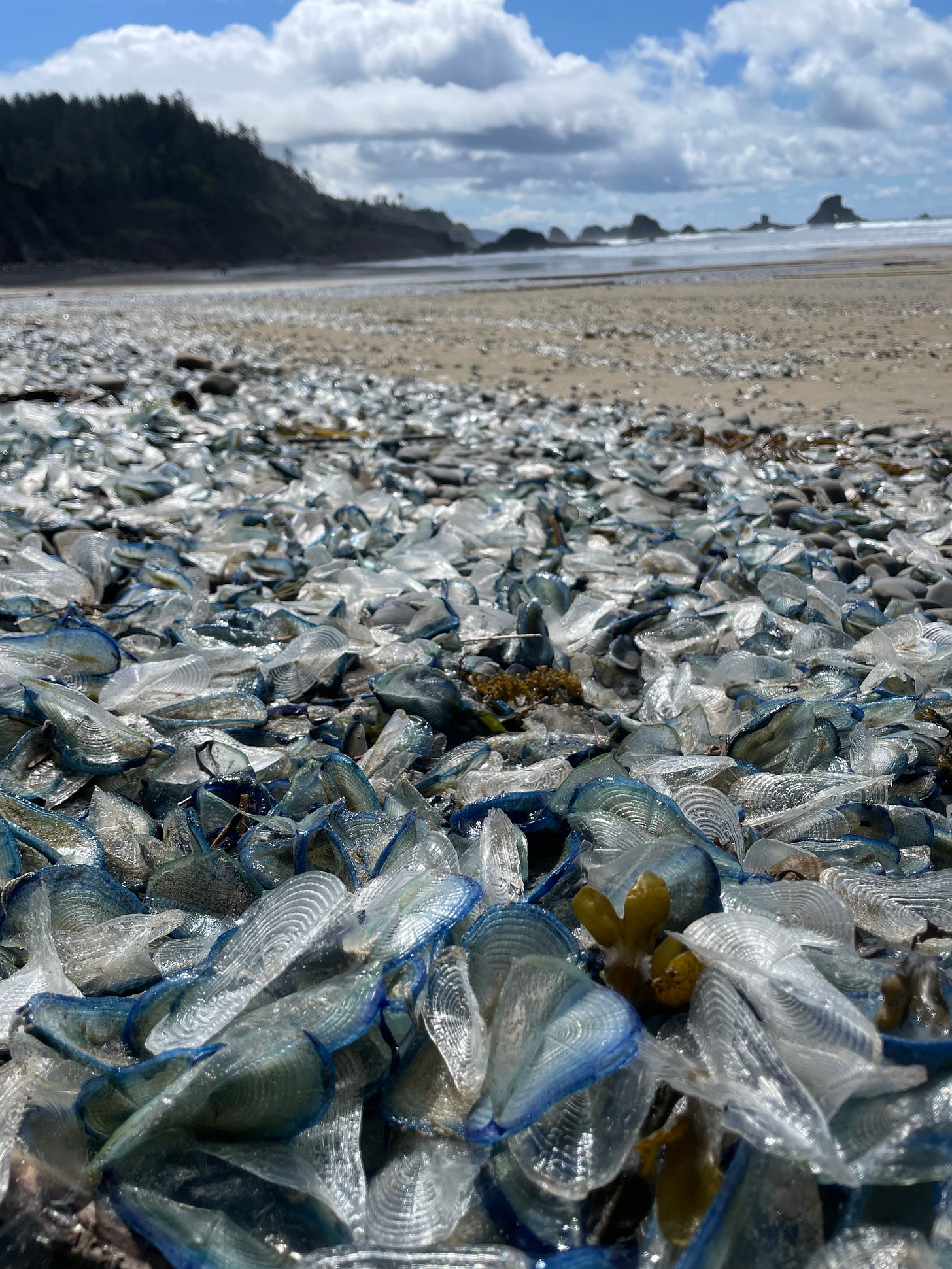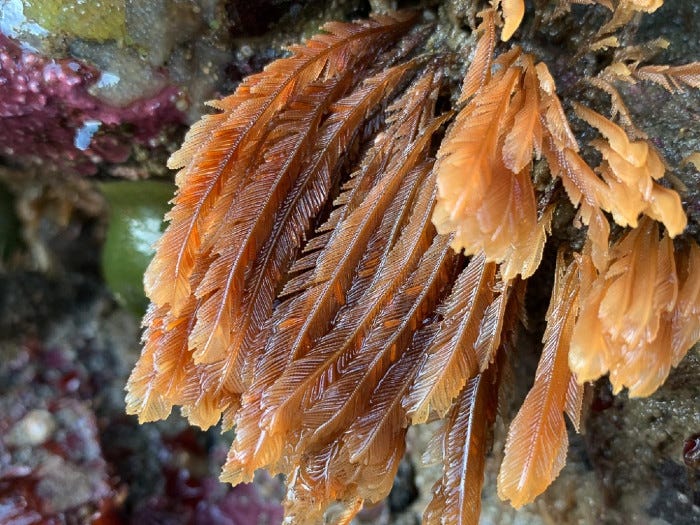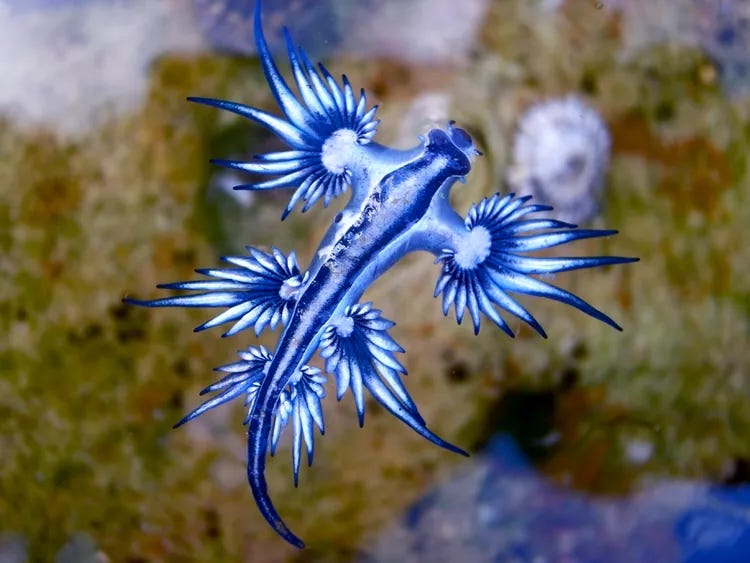A week ago I took my 90 year old father to a Cannon Beach and Ecola State Park on the Oregon coast. He took me camping, hiking, backpacking, skiing and mountain climbing when I was a kid so time to return the favor a little. He was and is a wonderful father.
On all the beaches there was a blue strip, typically 10 feet wide, consisting of thousands of 2-3 inch long by-the-wind sailor jellyfish —Velella drying out in the sun. A much bigger drift this year than usual I believe.
They are also called purple sails for the blue/purple sail they put up to catch the wind. They can’t power their movement but they can adjust the sail and put it up in the wind or take it down, so they are sailors They are carnivores who catch plankton (the food base of the whole ocean) with tentacles that hang down into the water. Their delightful scientific name is Velella Velella and the marine biologists say they are not actually jellyfish. Explaining what they are into gets the serious weirdness of invertebrate life in the ocean.
And most living things are invertebrates.When we too-smart walking apes think of animals we think of mammals, reptiles, birds, fish, amphibians— which are the main classes of vertebrates, they got back bones. But over 95% of animal species are invertebrates. The everything else category, 34 out of 35 phyla. On land invertebrates are ridiculously diverse but all fairly small, (insects, arachnids, snails, etc.) but in the ocean invertebrates get big.
Velella are in the diverse cnidarian phylum, which includes corals, sea anemones, “regular” jellyfish and hydroids, over 11,000 known species and plenty more unknown to science. Cnidarians (Prounounced Nigh-darian because the the C is silent like the P in swimming) are some of the oldest multi-cellular critters, some looking similar to how they did among the first known fossils of any kind from the Ediacaran, 580 million years ago. Molecular genetic studies of their mitochondria dates them tentatively back to 740 million years ago, all well before the Cambrian explosion when most animal groups first show up.
All cnidaria have cnidocytes which are explosive little structures that shoot miniature harpoons usually filled with poison to catch prey. This is why touching jellyfish can be an unpleasant or dangerous experience. Velella poison is strong enough to stun their prey but not strong enough to bother humans unless you decide to repeatedly roll naked on the part of the beach that is solid blue velella.
Velella are hydroids, most of which look like small feathery plants to us although some species get 6 foot wide in the deep ocean. Their shapes are very complex and wildly different among species as pictured in the classic biological art of Earnest Hackl here.
They are colonial animals, the little feathery plants are made of hundreds or many thousands of individual hydroid polyps. Most polyps specialize in eating, some in reproduction or defense (arm the cnidocyte harpoons!) They share nutrients through a hollow tube. Biologist call them colonial animals and consider the individual polyps to be separate animals, even thought the polyps of one colony are genetically identical, like the cells of our body. Why? Because there are living hyoids species that are equivalent to single polyps. Each polyp is multi-cellular and complex by itself. They can be considered a different way of putting together a complex life form, as opposed to the walking piles of trillions of cells all sharing the same DNA that we consider normal.
hydroid Ectopleura larynx photo: Alexander Semenov
Typical hydroid visible in a tide pool
Most hydroids are attached to the sea floor but Velella are a hydroid colony turned upside down and live on the open surface of the ocean, with a float and a sail instead of an anchor. The real estate is cheap, not many non-swimming animals live on the surface of the ocean and most who do are blue, which shields them from the harmful sun rays. Velella’s blue is provided by symbiotic photosynthetic algae that also supplies part of Velella’s energy needs. Between the colonial polyps and symbiotic algae, there’s a lot of cooperation going on with Velella.
Each velella colony is either male or female. They asexually pop out little medusae which look very much like tiny (1-3mm across) jellyfish. These medusa float along and spurt out male or female gametes which occasionally find each other and form new polyp colonies. All cnidarians have multiple life stages, sexual and asexual reproduction and some of them can even skip around the stages, like Turritopsis dohrnii, the immortal jellyfish, that goes backward and forward through the stages, never dying. Invertebrates are that kind of weird.
Coral, those other cnidarians, also get their colors and much of their energy from symbiotic photosynthetic algae. When water gets too warm the algae die and are flushed out, bleaching the coral white. The coral can survive a couple of years without the algae before it dies too. There is a rising epidemic of coral bleaching worldwide due to global warming and coral reefs are greatly endangered. Coral reefs have been around for more than 600 million years so even if global warming goes extreme, coral will eventually figure out a solution. But if it takes hundreds of thousands of years it won’t help humans or reef animals much. Perhaps this has happened before, in the many climate extremes of 600 million years? We don’t know, a coral reef gap of some hundreds of thousands of years wouldn’t really show up in the fossil record. We humans think one thousand years is a long time, ha!
Velella has specialist predators floating on the ocean with it, like the blue dragon nudibranch glaucus atlanticus.
Nudibranchs are sea slugs with exposed gills —nude-branchia, and they are the most psychedelically colored little animals in the world. Google nudibranch if you don’t believe me. Nearly all nudibranchs slug about on the ocean floor but blue dragons float and swim among the Velella colonies Velella has another floating cnidarian cousin***, portuguese man o’ wars, Physalia physalis. Man o’ wars are floating blue colonial sailors, but they are much larger, much more poisonous, and much better studied than Velella. We know that Man-of-wars are eaten by blue dragon nudibranchs, sunfish, and blanket octopus, all of whom have figured out how to recycle the powerful poison of the man-of wars. Blue dragons recycle the poison to their own cerrata tips, making them poisonous to their own predators. Blanket octopus have been observed carrying around man-of-war tentacles in their tentacles as defense. Does this count as using a defensive tool? Pom pom crabs do the same with urchins. Probably these predators prey upon Velella as well, we don’t know. In any case this gives me an excuse to put in a blanket octopus photo, those magical beauties.
Violaceous blanket octopus
*** Velella and man o’wars are cousins? Well not really, they’re both cnidarians but about as separate from each other as a cat is from a dog, But since each of these unique critters is the only species in their genus, they can be called cousins if you’re standing far way. Like on land.
OK, that’s more than enough crazy ocean beauty and bio-facts for now. “You don't know how much is enough until you know how much is too much.” William Blake.
Thanks for reading,











I like the perspective of standing on the land. Good work David!
Velella velellavelellavelellallellallellalle
This is great! Thanks!